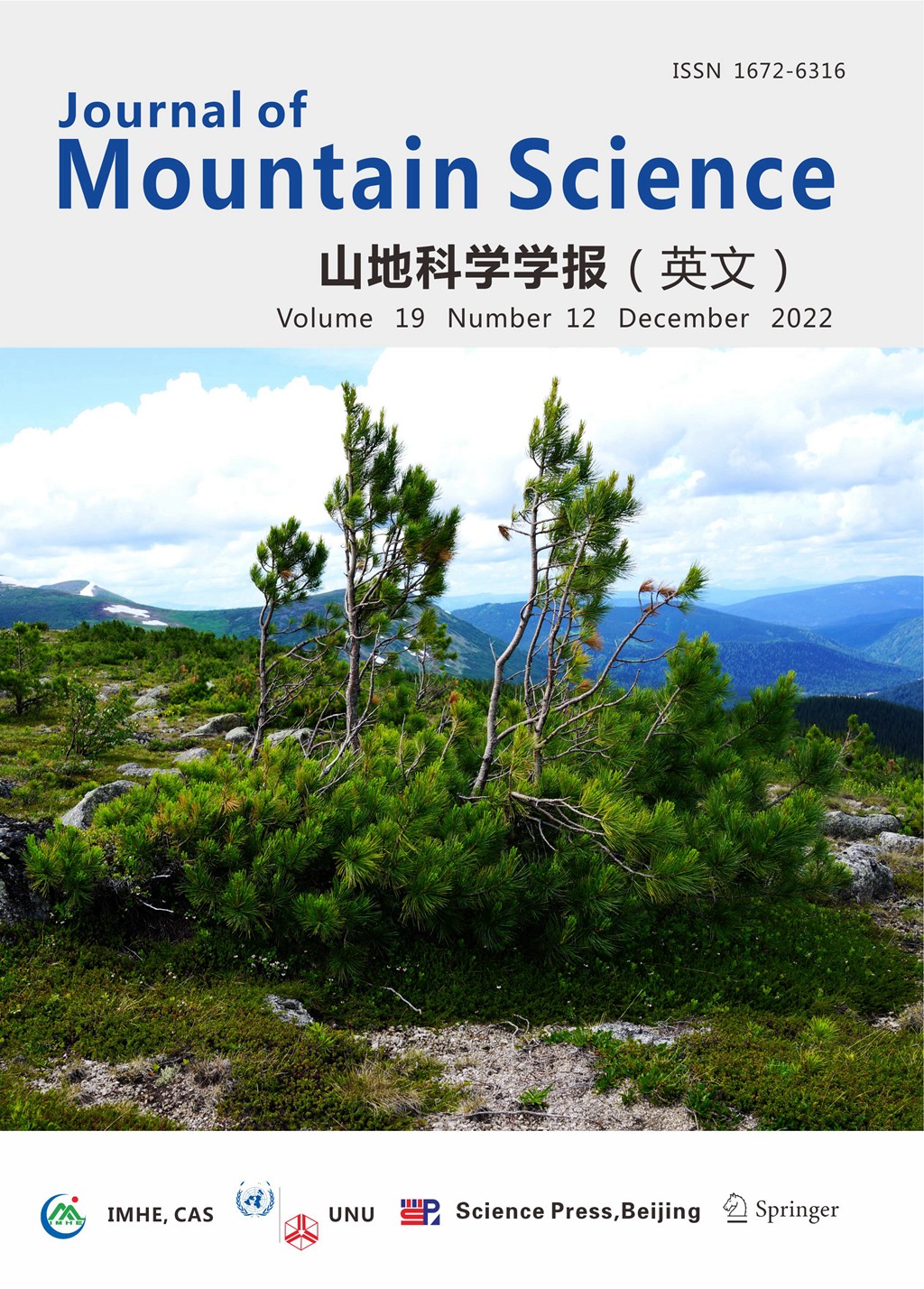博文
封面文章|西伯利亚树木集群向高山苔原的迁移
||
Journal of Mountain Science 编委俄罗斯科学院西伯利亚分院苏卡乔夫森林研究所的Kharuk教授从事高寒山区林线研究多年,分别在本刊发表过三篇与林线迁移有关的文章。2022年12期的封面文章西伯利亚树木集群向高山苔原的迁移(英文题目:Tree clusters migration into alpine tundra, Siberia)研究了西伯利亚地区林木向高山苔原迁移的规律。
Highlights:
1. 西伯利亚地区的林木向高山苔原迁移。
2. 西伯利亚高山苔原上树篱的形成。
3. 西伯利亚高山苔原的森林演化过程。
Citation: Kharuk VI, Petrov IA, Im ST, et al. (2022) Tree clusters migration into alpine tundra, Siberia. Journal of Mountain Science 19(12). https://doi.org/10.1007/s11629-022-7555-7
封面故事
西伯利亚山区的林线过渡带由西伯利亚松(Pinus sibirica Du Tour)、落叶松(Larix sibirica Ledeb)、冷杉(Abies sibirica Ledeb)和桦树(Betula tortuosa Ledeb.)组成。在迎风的山坡上,树木生长受限,低温、冬季季风和土壤湿度都会影响树木生长。树的针叶和细枝受风影响后会因干燥和冰雪擦伤造成树的外观发生变化,比如树形变成草垫状、屈曲状,树木生长下降,甚至死亡。为了适应向高山苔原迁移过程中恶劣多风的栖息地环境条件,树木形成了壮观的集群(树篱)。树篱总是沿着主风方向生长,树篱的形成与挡风的微地形特征(巨石、倒下的树木或洼地)密切相关。树木沿山坡向上迁移是通过树篱背风侧的幼树生长来实现的。
树篱作为潜在林分的核心,是一个自组织系统。一旦“领导”树建立,就会激发正反馈效应,促进幼苗生根和树篱内生境改善。树篱形成流线型的密集树冠,减轻了冬季季风的影响。在风大的栖息地,树篱内的树木呈草垫状、匍匐状或屈曲状。随着温度的升高,树干甚至小树枝开始直立起来。树篱的形成增加了积雪的沉积,减轻了季节性的水分压力,保护了树木免受干燥和雪的损伤。树篱的生长促进了土壤形成和土壤富集,使土壤养分浓度超过背景值1.5-5.5倍。树木的生长促进了“植物场”的形成,即在树篱周围长出草、地衣、苔藓和小灌木,它们的生长反过来又促进幼苗生根,其效率大约是植物场外的三倍。
随着栖息地的改善,如风速下降,气温升高和充足的水分供应,由于树篱内树木的生长和不同树种填补树篱之间的空隙,树篱逐渐演变为郁闭的森林。
《山地科学学报(英文)》2022年第19卷第12期的封面照片由俄罗斯科学院苏卡乔夫森林研究所的Kharuk教授于2022年7月7日拍摄,图片展示了西伯利亚库兹涅茨克阿拉托山脉西伯利亚松树所形成的树篱。这张照片是对文章“西伯利亚树木集群向高山苔原的迁移”的补充。
Cover Story
In Siberian Mountains, treeline ecotone is formed by Siberian pine (Pinus sibirica Du Tour), larch (Larix sibirica Ledeb), fir (Abies sibirica Ledeb) and birch (Betula tortuosa Ledeb.). On the windward slopes, tree growth is limited, alongside with air temperature, by winter winds and soil moisture. Winds cause needles and twigs damaged by desiccation and snow abrasion that lead to trees’ physiognomy changes (i.e., mat and krummholz formation), trees growth decrease, and mortality. As an adaptation to the harsh windy habitat and migration into the alpine tundra, trees form fascinating clusters (hedges). Hedges always orient along with the prevailing winds and its formation strongly links with wind-sheltering microtopography features (boulders, felled trees or local depressions). Trees’ uphill migration occurs by seedlings’ establishment within the leeward side of hedges.
Hedges, as the nucleus of the potential tree stands, are self-organizing systems. Once the “leader” tree establishes, a positive feedback is aroused that facilitates seedling rooting and in-hedge habitat amelioration. Hedges form streamlined dense crowns that mitigate the impact of winter winds. In the extremely windy habitat, in-hedge trees are presented in mat, prostrated or krummholz forms. With warming, tree stems and even twigs turn upright. Hedge formation increases snow deposition that mitigates seasonal water stress and protects trees from desiccation and snow abrasion. Hedge growth promotes soil formation and soil enrichment with nutrients whose concentrations exceed the background values by 1.5–5.5 times. Tree growth facilitates a “phytofield” formation, i.e., grasses, lichen, moss and small bushes, around the hedges that, in its turn, encourages seedling rooting which is about triple more efficient than outside the phytofield.
With habitat improvement such as decreased wind speed, warming and sufficient moisture supply, hedges evolve into closed forests due to both in-hedge tree growth and filling gaps between hedges by different tree species.
In the current issue in Journal of Mountain Sciences (Vol. 19 No. 12), the picture on the cover was taken by V. Kharuk of the Sukachev Institute of Forests, Russian Academy of Sciences on 7 July 2022, which shows an example of hedges formed by Siberian pine in the Kuznetsk Alatau Mountains, Siberia. This picture compliments the article “Tree clusters migration into alpine tundra, Siberia”.
相关文章:
1. Alpine ecotone in the Siberian Mountains: vegetation response to warming.
https://doi.org/10.1007/s11629-021-6876-2
2. Tree wave migration across an elevation gradient in the Altai Mountains, Siberia. https://doi.org/10.1007/s11629-016-4286-7
3. Characteristics of timberline and treeline altitudinal distribution in Mt. Namjagbarwa and their geographical interpretation. https://doi.org/10.1007/s11629-021-7214-4
4. Comparative analysis of the mass elevation effect and its implication for the treeline between the Tibetan and Bolivian plateaus based on solar radiation. https://doi.org/10.1007/s11629-021-6971-4
5. Identification and spatial pattern analysis of alpine timberline by remote sensing methods in Yarlung Zangpo Grand Canyon. https://doi.org/10.1007/s11629-020-6642-x
6. A review of modern treeline migration, the factors controlling it and the implications for carbon storage. https://doi.org/10.1007/s11629-020-6221-1
https://blog.sciencenet.cn/blog-314423-1375663.html
上一篇:JMS封面文章|溪洛渡电站库区水位变动和降雨下岩脚边坡的变形及其破坏机理
下一篇:封面文章|海拔的环境过滤作用影响热带山地植物系统发育多样性和物种丰富度
